In their latest Policy Direction, authors Fabio Carvalho, Hollie Blaydes and Alona Armstrong highlight key policy implications in relation to solar farm development and operation, and their usage in both addressing climate change and providing ecosystem benefits.
Back in April last year, we wrote about the need to gather standardised evidence on the impacts of solar farms on hosting ecosystems to inform industry best practice and maximise the environmental benefits solar farms can potentially deliver.
Since then, the Energy-Environment Research Team at Lancaster University have been continuing the quest to quantify such impacts and elucidate the role solar farms can play in promoting biodiversity and ecosystem services within wider landscapes.
We believe that if land is going to be converted into solar farms, it should be done in a way that is conducive to deliver wider benefits for people and nature.
We now turn our attention to public policies and how they can support the solar farm sector in delivering for nature, as much as for the climate, in a recently published Policy Direction piece in Journal of Applied Ecology.
Continued long-term growth
Despite the surge in solar energy adoption over the last five years in the UK, the Committee on Climate Change has recently reported on the need to increase the rate of solar energy installations by more than five times per year between now and 2030 if the UK Government is to meet its climate obligations under the 2015 Paris Agreement, as well as deliver its own target of reaching 70 GW installed solar energy capacity by 2035.

If the current proportion of approximately 55% of solar energy technology being deployed as solar farms remains constant (with the remaining 45% split between rooftop and floating installations), solar farms may come to occupy ~ 72,900 ha of land in the UK by the mid-2030s (or approximately 0.3% of the total UK land area). However, these figures may well need revising upwards in the coming months given the new Government’s seemingly bolder action on climate change compared to the previous. The Labour Government has acted swiftly in approving three very large solar farms in the east of England that are set to deliver about two-thirds of the entire solar energy capacity installed in 2023.
Given the environmental benefits solar farms can potentially deliver, we have often focused our research on identifying ways to minimise detrimental consequences and maximise nature enhancements. We have worked closely with ecological consultancies and the solar energy sector to develop best practices for site management and subsequent biodiversity monitoring. However, research and practice will likely be insufficient to deliver ecological outcomes if appropriate public policies are not in place to support (or rather incentivise) industry best practice to achieve a sustainable low-carbon energy transition.
The UK policy landscape to date
Several policy documents issued over the past 14 years have played a key role in driving solar farm development in the UK, initially through the feed-in tariffs and the renewables obligation certificates of the early 2010s, and more recently through the decarbonisation and net-zero strategies of the early 2020s. These have been instrumental (at least from a policy perspective) in setting out plans for a ‘green industrial revolution’ and establishing frameworks to fully decarbonise the UK’s electricity grid.

Despite policy changes over the years, more could be done to capitalise on the opportunities some of these developments can offer in terms of dual or triple land use options. Perhaps most notably, land use change for solar farms could be used to restore degraded habitats and benefit wildlife in previously intensively managed agricultural land.
Consequently, biodiversity-related policies in the UK, mostly underpinned by the UN Convention on Biological Diversity, have had little influence so far on how solar farms are built and managed. Crucially, policies aimed at increasing biodiversity on agricultural land have made land parcels containing solar panels ineligible for most public financial incentives.
Future policy drivers must integrate climate and biodiversity targets
It remains to be seen what impact the recently adopted Biodiversity Net Gain (BNG) initiative will have on solar farm developments in England, given the new requirement to deliver at least 10% increase in biodiversity compared to pre-development conditions (and at last solar farms are eligible to take part).
This alone, however, is unlikely to deliver the multiple positive outcomes needed to result in the net environmental and societal benefits we want to see from the expansion of solar farms across the country.
In a joint effort involving researchers from Lancaster University and the University of York, as well as practitioners from Clarkson & Woods Ecological Consultants and industry and policy insiders from NextEnergy Capital and the National Farmers’ Union, we have recently offered a series of recommendations for public policymakers in the UK and beyond to enable solar farms to realise their full potential. In addition to integrating international climate and biodiversity targets into coherent policy instruments that can benefit climate and nature simultaneously, we have also argued for several other policy-related actions, including the formulation of ecological and socio-economic indicators and metrics that can underpin the development, implementation, and assessment of public policies, and the addition of solar farms into biodiversity-inclusive spatial planning policies and decision-making.
It seems several policy changes may be required under the new UK Government to deliver the levels of investment and infrastructure needed to achieve a Net Zero energy system in the UK by 2030. On top of that, public policies should also strive to create the right conditions in which solar farm operators can deliver dual outcomes for climate and nature. Our Policy Direction piece is hopefully a significant step forward in guiding future policy and in making a positive case for the low-carbon energy transition.
Read the full article, “Integrated policymaking is needed to deliver climate and ecological benefits from solar farms” in Journal of Applied Ecology.
